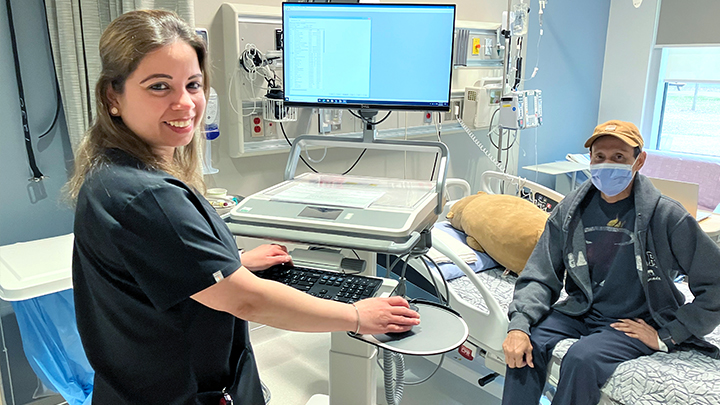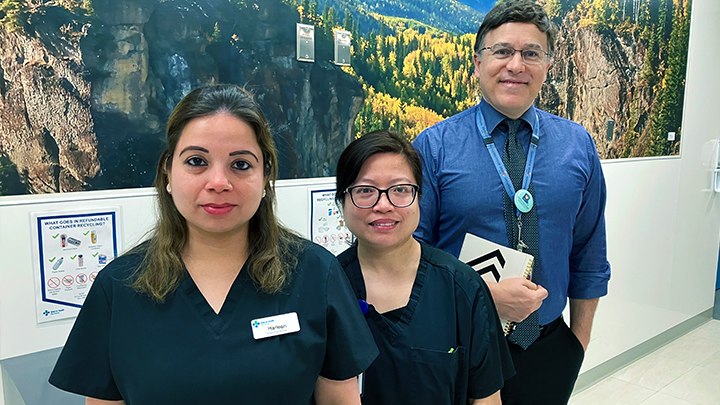
June 2, 2025

Harleen Heer Sran, a Food Services administrative support at Grande Prairie Regional Hospital, talks to patient Eduardo Triones to take his meal preferences for the next day as part of the bedside menu selection program. Photo by Sara Blake.

Nutrition and Food Services team members Harleen Heer Sran, left, Alona Estacio and Hisham Karami focus on bringing the patient voice into their work through bedside menu selection at the hospital. Photo by Sara Blake.
Story by Katie McLaughlin | Photos by Sara Blake
GRANDE PRAIRIE — Imagine being in the hospital and having the opportunity to select what you eat and drink for each meal from a large menu of options with the help of patient food service staff. No more setting aside food you don’t like or eating a meal that you don’t particularly want while you’re feeling unwell. Your meals are your choice, based on your preferences and medical condition.
For many patients at the Grande Prairie Regional Hospital, this is their reality thanks to the bedside menu selection program offered by the hospital’s Nutrition and Food Services team. Launched in 2021, it’s a program that helps staff better meet the unique needs and preferences of their patients.
“Every day I go to the units and meet with eligible patients to discuss the menu options for the following day, and they pick what they want to eat and drink,” says Harleen Heer Sran, a Food Services administrative support at the hospital. “We’re focusing on what matters to patients by providing more choice of what they can eat while they’re in the hospital, which is improving their experience.”
Before bedside menu selection, staff did their best to note likes and dislikes in the nutrition system so it would automatically select something else. However, this process didn’t always reflect the needs or preferences of the patient on a particular day.
“Sometimes patients still didn’t want to eat what the nutrition system automatically selected for them that day, even if the selections were based on their preferences,” says Hisham Karami, manager, Nutrition and Food Services at the hospital.
“We wanted to focus on enhancing the patient voice in our work, so we looked into new technology when we moved into the new hospital and transitioned to bedside menu selection. We’re noticing now that patients are eating more, we’re wasting less and, overall, the feedback we’re receiving from patients suggests an increase in satisfaction.”
Eduardo Tirones was introduced to bedside menu selection during his April stay at the hospital. He says he likes the opportunity to pick what he wants to eat, and felt better knowing that he could eat everything that was on his meal tray.
“When I was being asked what kind of food I want the next day, it was much better,” he says. “They give me choices for my meals, and I can remove foods that I don’t want or can’t eat. It’s nice having variety in food so I’m not forcing myself to eat something. I can pick whatever I want.”
Tirones adds that the helpful interaction from staff like Heer Sran and others on the unit lessens the emotional and physical stress of his illness — and he can feel their concern for his health — and knows that they want him to feel better and heal.
Karami says this program also has the potential to help combat another challenge they face in the hospital — malnutrition. It can be an issue when patients are sick and not interested in eating — and the food they receive isn’t enticing to them. “Bedside menu selection provides opportunities for equity and inclusion, for those who need to reflect their identity, beliefs or culture into the meals they get. They can do that through this process.” Not every patient is able to participate in bedside menu selection; for example, some patients are on a limited diet due to upcoming surgery or might be on a fluid-only diet where there isn’t much choice.
However, Karami’s team still does their best to note patient preferences and personalize selections wherever possible, even if it’s limited to a choice of flavours of broth, for example. If the patient can return to regular food during their hospital stay, they’re included in bedside menu selection.
Aside from the positive impacts on patients and staff, Karami notes they’ve also seen a notable decrease in food waste and a more efficient, streamlined process for the team that allows them to focus on tasks that truly matter to patients.
For Heer Sran, there’s an additional benefit — increased job satisfaction and motivation.
“This has given me a stronger relationship with patients,” she says. “Before, I was working in the office and didn’t have any interaction with patients. Now, I talk to them every day and it gives me satisfaction to do something that makes a difference to them. Seeing the appreciation from the patients motivates me and shows that I’m making a difference in somebody’s life.”
She adds that the increased interaction with the registered dietitians and nursing staff has been positive and helps her feel like a bigger part of the team.
“Patients thank our staff in person, or they leave notes, and we see that the effort of the team is appreciated,” says Karami. “I’ve heard from staff that this means a lot to them, and they feel like coming to work adds value for the patient. It’s a meaningful job.”
Every year on June 6, Alberta Health Services celebrates “What Matters to You?” Day. Learn more here.